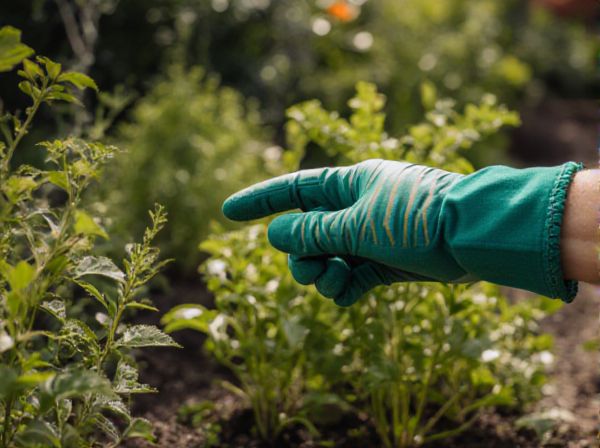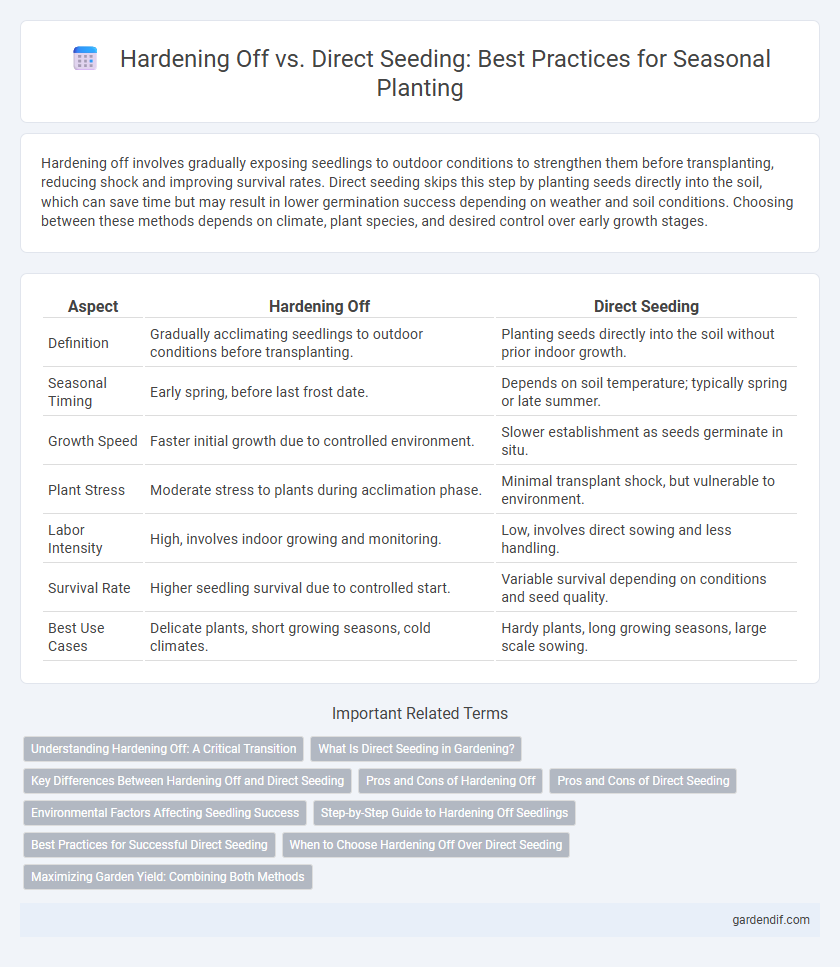
Hardening off vs Direct seeding Illustration
Hardening off involves gradually exposing seedlings to outdoor conditions to strengthen them before transplanting, reducing shock and improving survival rates. Direct seeding skips this step by planting seeds directly into the soil, which can save time but may result in lower germination success depending on weather and soil conditions. Choosing between these methods depends on climate, plant species, and desired control over early growth stages.
Table of Comparison
| Aspect | Hardening Off | Direct Seeding |
|---|---|---|
| Definition | Gradually acclimating seedlings to outdoor conditions before transplanting. | Planting seeds directly into the soil without prior indoor growth. |
| Seasonal Timing | Early spring, before last frost date. | Depends on soil temperature; typically spring or late summer. |
| Growth Speed | Faster initial growth due to controlled environment. | Slower establishment as seeds germinate in situ. |
| Plant Stress | Moderate stress to plants during acclimation phase. | Minimal transplant shock, but vulnerable to environment. |
| Labor Intensity | High, involves indoor growing and monitoring. | Low, involves direct sowing and less handling. |
| Survival Rate | Higher seedling survival due to controlled start. | Variable survival depending on conditions and seed quality. |
| Best Use Cases | Delicate plants, short growing seasons, cold climates. | Hardy plants, long growing seasons, large scale sowing. |
Understanding Hardening Off: A Critical Transition
Hardening off is the crucial process of gradually acclimating seedlings to outdoor conditions before transplanting, enhancing their survival rate during seasonal transitions. This method reduces transplant shock by exposing plants to varying temperatures, wind, and sunlight over 7 to 14 days, ensuring stronger growth compared to direct seeding. Understanding hardening off enables gardeners to optimize plant development and improve yield in seasonal planting cycles.
What Is Direct Seeding in Gardening?
Direct seeding in gardening involves planting seeds directly into the soil outdoors, bypassing the need for indoor germination or transplanting seedlings. This method leverages the natural seasonal conditions, allowing seeds to develop in sync with local climate patterns and soil temperatures. Direct seeding reduces transplant shock and labor but requires careful timing to ensure seeds have optimal conditions for germination and growth.
Key Differences Between Hardening Off and Direct Seeding
Hardening off involves gradually acclimating seedlings to outdoor conditions to reduce transplant shock, while direct seeding bypasses indoor nurturing by sowing seeds directly into the soil. Key differences include the control over early growth environments, with hardening off offering more protection and higher survival rates, whereas direct seeding relies on natural conditions and may face higher seedling mortality. Hardening off is time-intensive and suited for tender plants, whereas direct seeding is faster and better for hardy, quick-germinating species in appropriate seasonal climates.
Pros and Cons of Hardening Off
Hardening off young seedlings improves their resilience by gradually acclimating them to outdoor conditions, reducing transplant shock and increasing survival rates. However, this process demands time, dedicated space, and careful monitoring of temperature, humidity, and sunlight exposure, which can be labor-intensive. Direct seeding bypasses these steps but exposes plants to higher mortality risks from weather fluctuations and pests.
Pros and Cons of Direct Seeding
Direct seeding offers advantages such as lower labor costs and faster planting compared to hardening off, allowing seeds to germinate and grow directly in the field during the ideal planting season. However, it poses risks including vulnerability to adverse weather conditions, pests, and inconsistent germination rates, potentially leading to uneven crop stands. Despite these challenges, direct seeding remains a preferred method in suitable climates due to its simplicity and time efficiency during the planting season.
Environmental Factors Affecting Seedling Success
Hardening off seedlings involves gradually exposing young plants to outdoor environmental conditions like fluctuating temperatures, wind, and sunlight, which enhances their resilience and increases survival rates. Direct seeding places seeds straight into the soil, relying on optimal soil moisture, temperature, and protection from pests and extreme weather for successful germination and growth. Environmental factors such as soil quality, rainfall patterns, and seasonal temperature shifts critically influence seedling vigor and overall crop establishment in both methods.
Step-by-Step Guide to Hardening Off Seedlings
Gradually expose seedlings to outdoor conditions over 7 to 10 days, starting with 1-2 hours in a shaded, protected area and increasing both time and sunlight exposure daily. Monitor moisture levels closely, ensuring seedlings do not dry out or experience extreme temperature fluctuations during the hardening off process. This step-by-step hardening off method strengthens seedling cell walls, improves resilience against wind and sun, and significantly enhances transplant survival rates compared to direct seeding.
Best Practices for Successful Direct Seeding
For successful direct seeding, select hardy seed varieties suited to local climate conditions and plant after the last frost date to ensure optimal soil temperature. Maintain consistent soil moisture without waterlogging and thin seedlings promptly to prevent overcrowding. Implement gradual exposure to outdoor conditions for young plants by hardening off seeds when started indoors to improve survival rates and reduce transplant shock.
When to Choose Hardening Off Over Direct Seeding
Hardening off is ideal during transitional seasons like spring when seedlings need gradual exposure to outdoor conditions before planting, reducing transplant shock. Direct seeding suits frost-free periods with stable temperatures, avoiding the extra step of acclimating young plants. Choose hardening off when early-season cold snaps or fluctuating weather threaten seedling survival and growth.
Maximizing Garden Yield: Combining Both Methods
Hardening off seedlings before transplanting strengthens plant resilience and improves survival rates, leading to higher garden yields. Direct seeding allows crops to develop root systems undisturbed, often resulting in faster growth and more robust plants. Combining hardening off with selective direct seeding optimizes plant health and maximizes overall garden productivity by leveraging the strengths of both methods.
Hardening off vs Direct seeding Infographic

 gardendif.com
gardendif.com